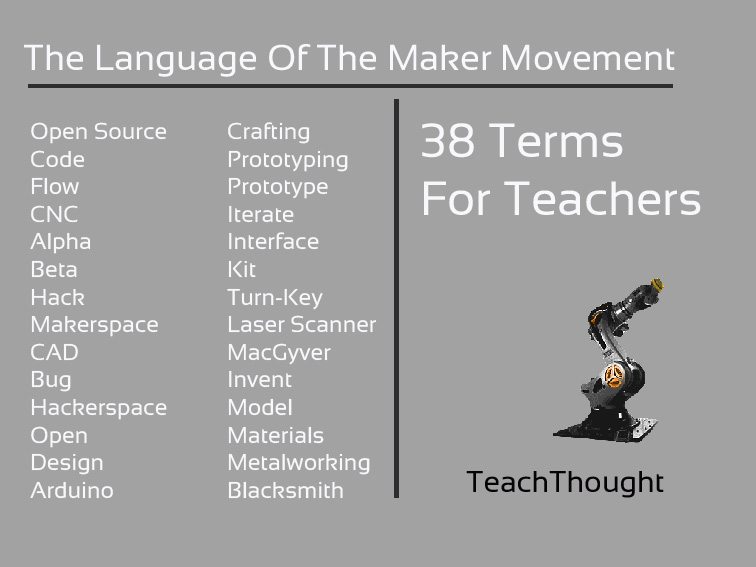38 Maker Movement Terms And Definitions For Teachers
As with any niche, there is jargon that may keep things murky for you. Here are 38 examples of the maker movement language.

38 Terms Of The Maker Movement
As the maker movement in culture moves from MacGyver jokes and what Noah did when Allie left him in The Notebook to something with a bit more academic and cognitive credibility, it has also begun to creep into the education space.
As with any niche, there is specialized language–jargon–that may keep things murky for you. The 38 terms below by no means represent an exhaustive collection. (There are dozens of gadgets, circuit boards, and digital, robotic, and electrical wizardry we left on the cutting room flow.) But for most teachers in most circumstances, it should serve as a nice starting point.
(Which reminds us–here is a similar post on neurological terms in education.)
1. 3D Printing
The printing of objects rather than paper. (One day this will almost certainly include human organs, so there’s that.)
2. Alpha
A very early build, or model; ‘alpha’ products can come in a variety of states of production, from completely unfinished to nearly ready for beta testing
3. Arduino
“An open-source electronic prototyping platform.” (see arduino.cc)
4. Beta
A build that lacks polish and refinement, but is mostly functional and ready for more widespread testing
5. Blacksmiths
A metalsmith that crafts metal objects with elemental tools (e.g., steel, water, hammers); the O.G.s of makers
6. Bug
A flaw in design or execution, often referring to an error in computer code.
7. Coding
The collection of alphanumeric characters in certain computing languages to produce software, including apps, games, and web design
8. Crafting
The combination of two or more ingredients to make something new; see everything from cooking to Minecraft
9. CAD
Computer-Aided Design
10. CNC
A machine used to precisely cut and shape physical materials, including metal and wood
11. DIY
Do-It-Yourself
12. DIT/DIWO
Do-It-Together/Do-It-With-Others; collaborate
13. Design
Strategic decisions for a specific purpose–project-based learning, for example.
See also Articles About Project-Based Learning
14. Electronics
The design, study of, and experimentation with hardware (of any size) energized by electricity (of any amount)
15. Hack
To strategically probe, analyze, break, or hi-jack; a revision of existing software or hardware to make it perform in a way other than it was designed
16. Hackerspace
A digital or physical space where one or more hackers adjust existing designs for a variety of purposes
17. Interface
How/where a user interacts with software or hardware
18. Invent
To create something that didn’t exist before
19. Iterate
To update a design—e.g., with new features, functions, elegance, etc.
20. Flow
A mental state characterized by autonomy, creativity, and full cognitive immersion
21. Kit
A pre-designed set of materials, often ‘turn-key,’ ready to assemble
22. Laser Scanner
Laser hardware that can create a 3D digital representation of a physical environment; also called a 3D scanner
23. MacGyver
A hero.
24. Make
To move from design to product; to build, craft, conjure, code, or otherwise manifest
25. Makerspace
A garage space, classroom corner, workbench, design lab, or other area where the actual physical construction of designs occur
26. Materials
The diverse and working ingredients of making–paper, cardboard, blocks, wires, circuit boards, gears, batteries, USB, paint, wood, rubber, etc.
27. Metal and Wood Crafting
The creation of traditionally crafted items, including cabinets, gates, lamps, and other often functional products
28. Model
The use of an existing ‘design’ for new design ideas
29. Open
A philosophy of sharing (ideas, resources, and approaches) and transparency (designs, failures, and successes)
30. Open Source
The communal building and iteration of existing software or hardware; the formal practice of sharing design
31. Play
An underlying tone of ‘making,’ and a critical dynamic of the Maker Movement
32. Prototype
The first example of a design; an early model built for testing purposes
33. Reverse Engineering
The discovery of design thinking and function through the analysis—and sometimes deconstruction—of existing functioning models; unbuilding stuff to see how it’s made
34. Robotics
The use of mechanized and humanoid
35. Smith
A maker usually specializing in metal
36. Tinker
The playful and curious interaction between a maker and their ‘things’
37. Turn-Key
A kit ready complete with everything necessary to function.
38. Rapid Prototyping
The approach of design through refinement; creating an often crude alpha model for the purpose of testing; this approach is characterized by a fast development cycle and long-term iteration, rather than extended development leading towards a production-ready product
The Language Of The Maker Movement: 38 Terms For Teachers
